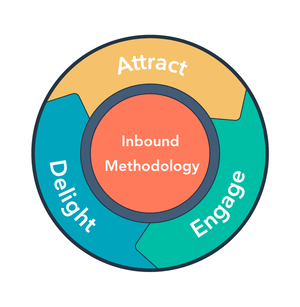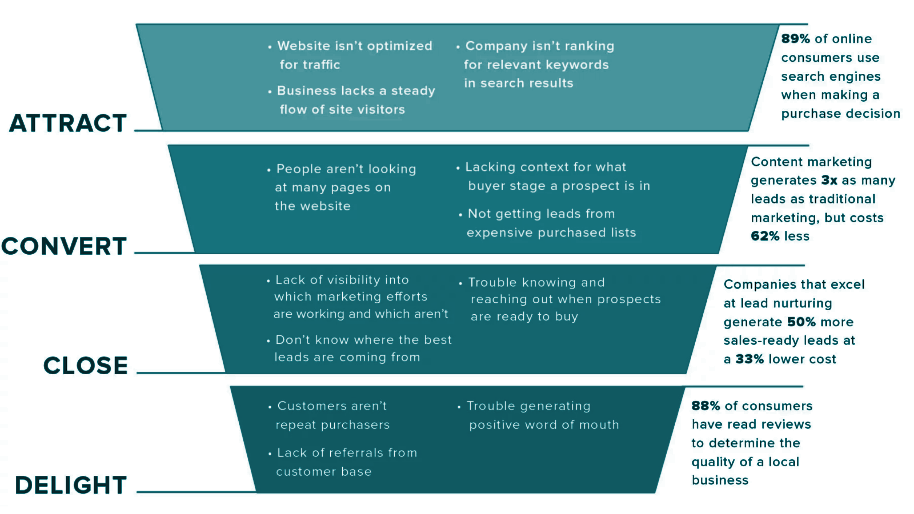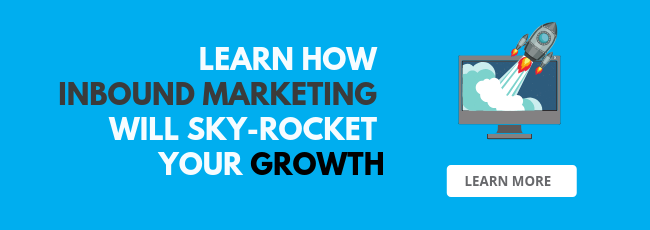Introduction to Inbound Methodology and Inbound Marketing
The Inbound Marketing Blog Series: Part 1 | Part 2 | Part 3 | Part 4 | Part 5
Inbound is a methodology connecting ALL of your digital sales, marketing and customer service activities and tactics to grow your business with more of the right traffic and leads, produce and retain more customers and increase ROI.
The inbound methodology is composed of three stages (that also happen to represent a customer's journey) namely: attract, engage (convert and close) and delight.
Inbound is about adding value at every stage of the customers journey.

Image reference: HubSpot Inc.
From a business perspective, the methodology represents the growth of a business - inbound businesses use the methodology to build trust, credibility, and momentum.
Inbound can shape your creative focus to ensure you produce quality content and exceptional customer experiences that pull customers towards your organisation and marketing channels by aligning their interests.
What is ‘Inbound’ Marketing?
Using the above mentioned Methodology in Marketing is known as Inbound Marketing. It is important to understand the steps to inbound marketing that Inbound applies in a digital sense.
In a digital world, traditional or 'old-school' marketing (4 P's, PR, letter-box, print, phone) has become in many instances ineffective, expensive and a thing of the past and often obsolete.
For modern marketers (and modern salesman), control has shifted from the business or brand directly to the customer. Outbound marketing no longer fits into a data-guided world.
For over a decade, Inbound methodology has been combined with emerging modern Marketing techniques, tools and tactics to become a proven and scientific technique regaining control for marketers and nurturing customers for sales.
Modern marketing techniques, tools and tactics include websites, social media, email marketing, content strategy, PPC, SEO, video, blogging, CRM, lead flows, conversational bots, marketing automation, smart and dynamic content, attribution reporting...the list goes on.
Modern marketing and inbound (Inbound Marketing) leverage strategic and fundamental elements - a deep understand of the ideal target customer or buyer persona, their customer buyer journey and a precise content strategy to present the business solution in the moment customers need it most.
Image reference: HubSpot Inc.
Understanding Inbound Marketing
For inbound marketers, the goal is to attract new prospects to your company, streamline your marketing, engage with them at scale, and delight them individually, to effectively help the business grow. It's a big job, but the inbound methodology has you covered - conceptually, it looks like this:
A diagrammatic and easy-to-grasp business use-case for inbound marketing:
Like this diagram? There's more to the picture, get the rest here >
Now that this blog has introduced you to the Inbound methodology, we know you will enjoy the rest of the blogs in the series.
Written by Glenn Miller
An exceptionally experienced digital marketer, proactive and future-forward thought leader, I deliver exceptional customer experiences, industry leading digital strategy and superior marketing results.
SUBSCRIBE TO OUR BLOG
SUBSCRIBE TO OUR BLOG
Popular
Categories
- Inbound Marketing (94)
- Digital Marketing Strategy (85)
- Content Marketing (29)
- Lead Management (27)
- Artificial Intelligence (AI) (26)
- Business Growth (26)
- HubSpot (26)
- CRM (23)
- Marketing Automation (20)
- Email Marketing (16)
- Sales Enablement (14)
- Referral Marketing (12)
- Customer Relationship Management (CRM) (11)
- Social Media Marketing (8)
- Blogging (7)
- Buyer Personas (7)
- HubSpot Product Feature Updates (7)
- Buyer Journey (6)
- Growth Driven Website Design (6)
- content strategy (6)
- Goal Setting (5)
- Paid Media (4)
- SEO (3)
- Influencer Marketing (2)
- Sales & CRM HUG ANZ (2)
- Conversational Marketing (1)
- Legal practice management software (1)
- User Management (1)
- training (1)



